CHCDEV002: Sociological Factors Affecting Clients in Community Work
VerifiedAdded on 2023/06/09
|7
|2010
|180
Case Study
AI Summary
This case study examines the impacts of sociological factors on clients within community services, focusing on Northcott disability service and Lifeline disability services in the Australian context. It identifies major social and cultural institutions involved, analyzes how these institutions impact clients as individuals and within community and family groups, and explores the effects of inequality on clients. The study also describes the client groups of each service, analyzes the social and cultural factors impacting them, and discusses how to monitor the impact of the work undertaken by each service. Finally, it assesses the potential impact on clients and the community if these services were to discontinue, highlighting the importance of disability services in promoting equality, well-being, and community support.
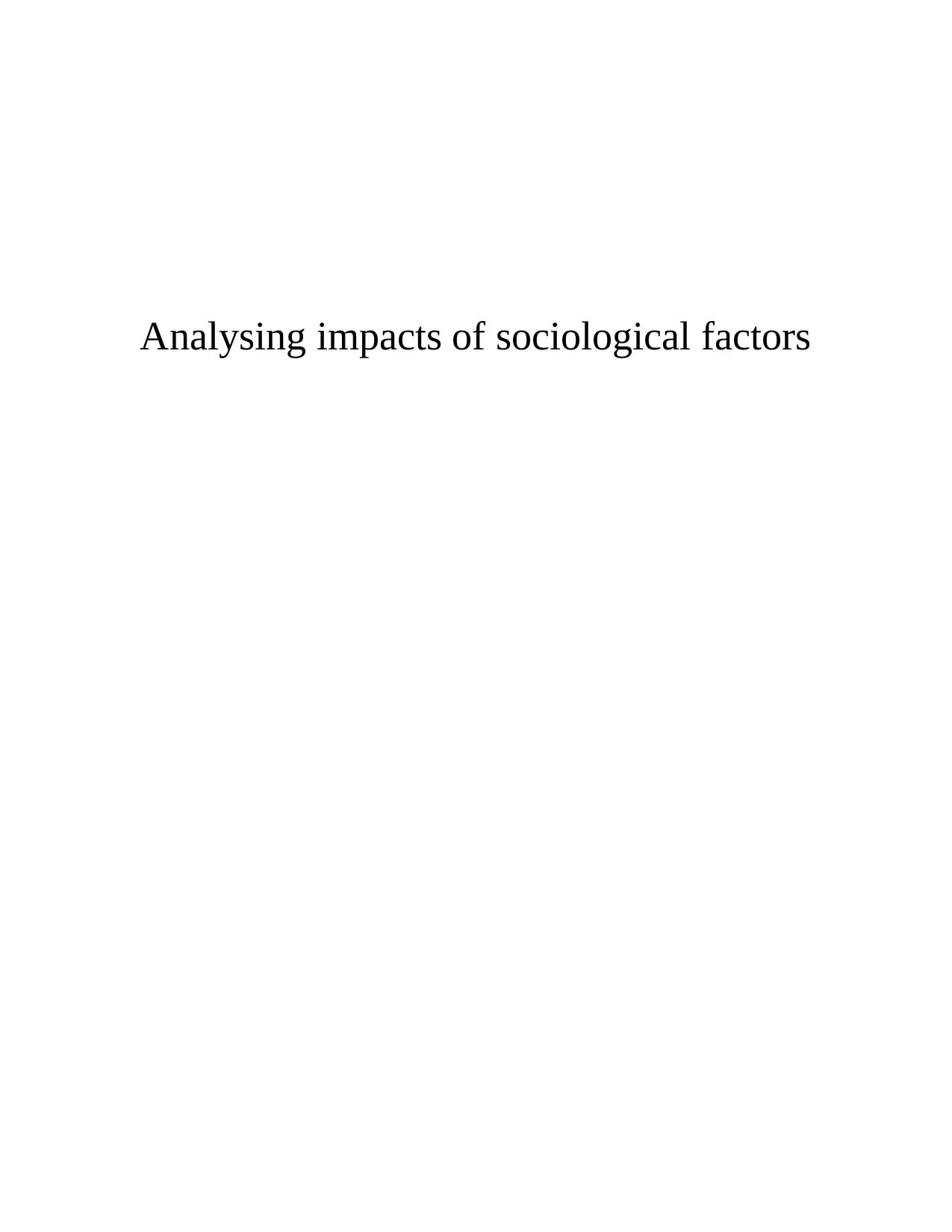
Analysing impacts of sociological factors
Paraphrase This Document
Need a fresh take? Get an instant paraphrase of this document with our AI Paraphraser
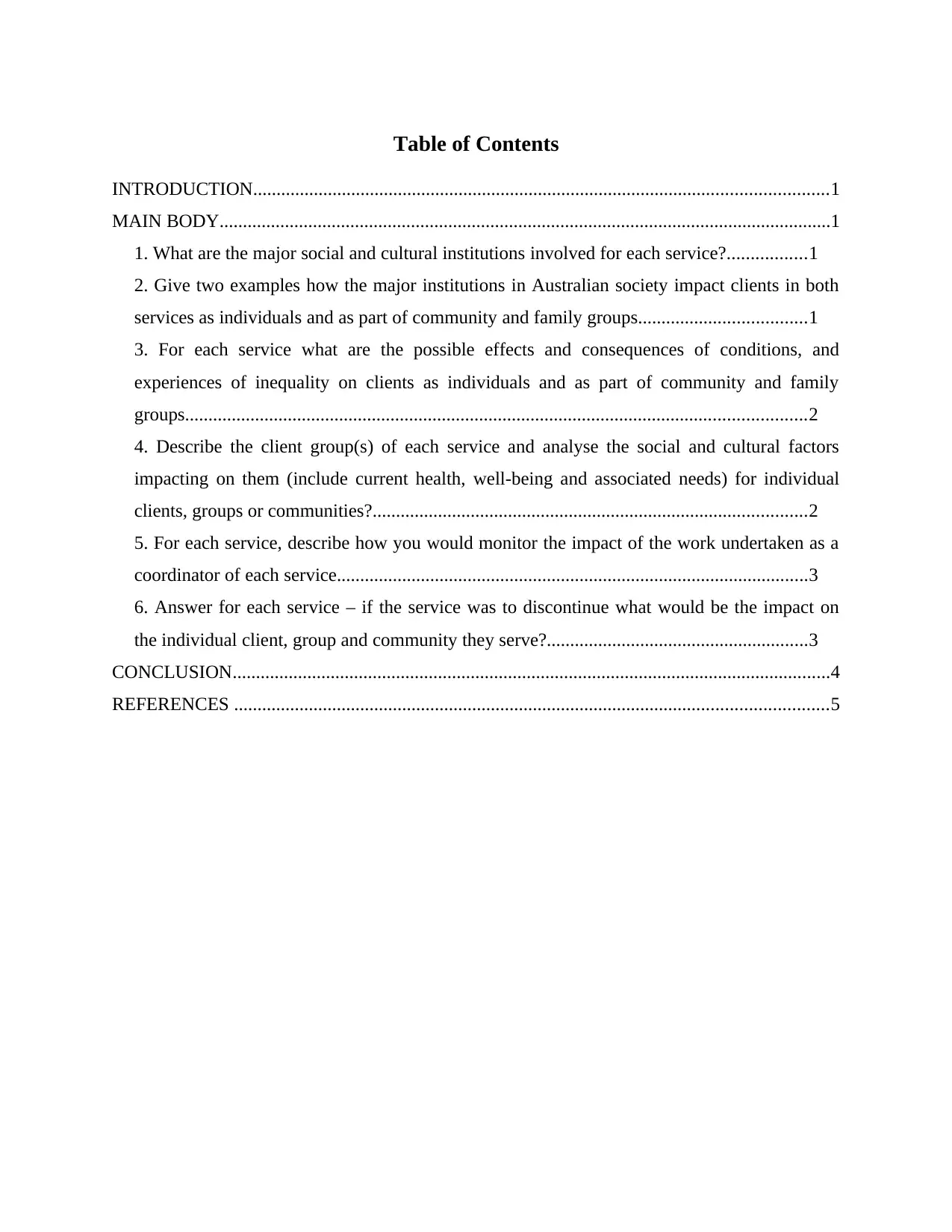
Table of Contents
INTRODUCTION...........................................................................................................................1
MAIN BODY...................................................................................................................................1
1. What are the major social and cultural institutions involved for each service?.................1
2. Give two examples how the major institutions in Australian society impact clients in both
services as individuals and as part of community and family groups....................................1
3. For each service what are the possible effects and consequences of conditions, and
experiences of inequality on clients as individuals and as part of community and family
groups.....................................................................................................................................2
4. Describe the client group(s) of each service and analyse the social and cultural factors
impacting on them (include current health, well-being and associated needs) for individual
clients, groups or communities?.............................................................................................2
5. For each service, describe how you would monitor the impact of the work undertaken as a
coordinator of each service.....................................................................................................3
6. Answer for each service – if the service was to discontinue what would be the impact on
the individual client, group and community they serve?........................................................3
CONCLUSION................................................................................................................................4
REFERENCES ...............................................................................................................................5
INTRODUCTION...........................................................................................................................1
MAIN BODY...................................................................................................................................1
1. What are the major social and cultural institutions involved for each service?.................1
2. Give two examples how the major institutions in Australian society impact clients in both
services as individuals and as part of community and family groups....................................1
3. For each service what are the possible effects and consequences of conditions, and
experiences of inequality on clients as individuals and as part of community and family
groups.....................................................................................................................................2
4. Describe the client group(s) of each service and analyse the social and cultural factors
impacting on them (include current health, well-being and associated needs) for individual
clients, groups or communities?.............................................................................................2
5. For each service, describe how you would monitor the impact of the work undertaken as a
coordinator of each service.....................................................................................................3
6. Answer for each service – if the service was to discontinue what would be the impact on
the individual client, group and community they serve?........................................................3
CONCLUSION................................................................................................................................4
REFERENCES ...............................................................................................................................5
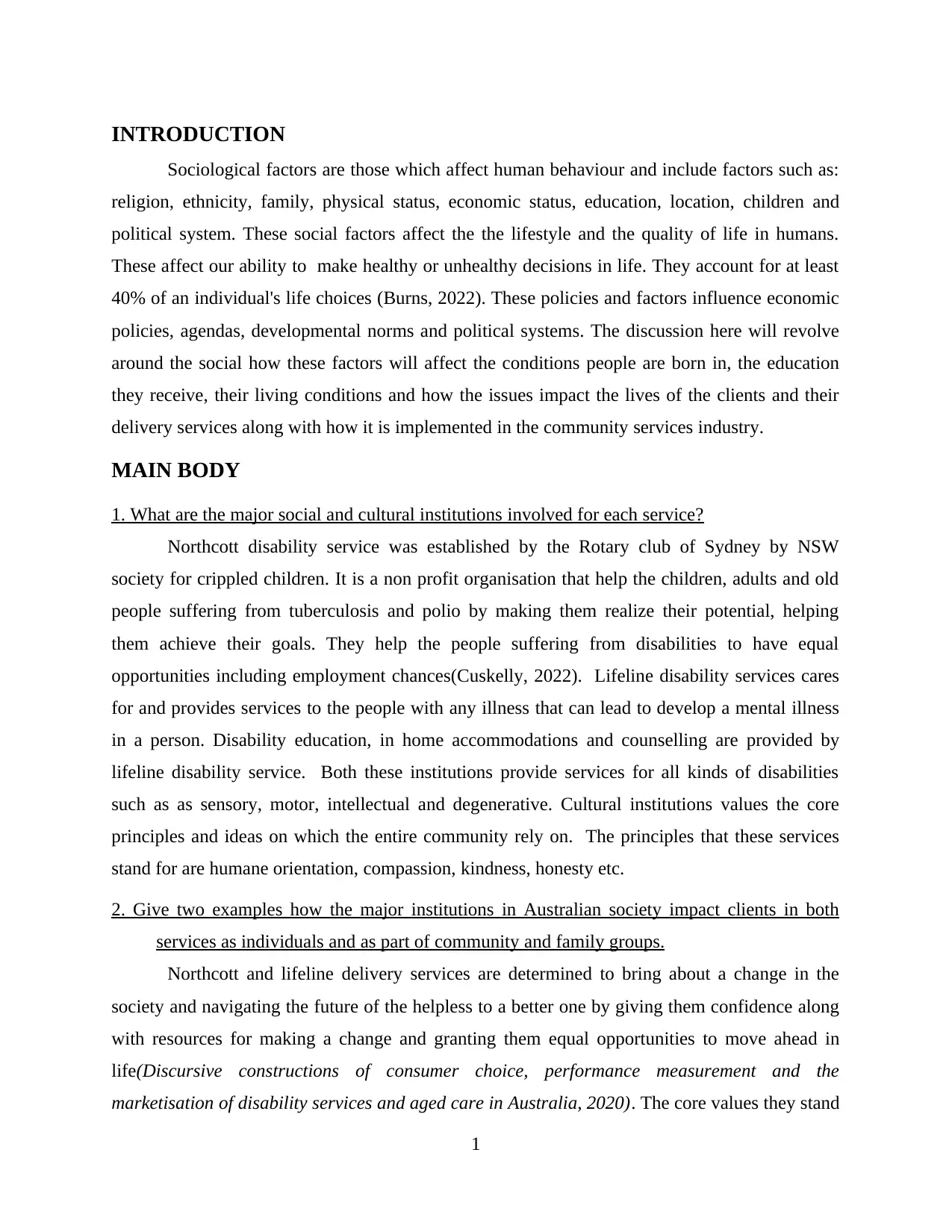
INTRODUCTION
Sociological factors are those which affect human behaviour and include factors such as:
religion, ethnicity, family, physical status, economic status, education, location, children and
political system. These social factors affect the the lifestyle and the quality of life in humans.
These affect our ability to make healthy or unhealthy decisions in life. They account for at least
40% of an individual's life choices (Burns, 2022). These policies and factors influence economic
policies, agendas, developmental norms and political systems. The discussion here will revolve
around the social how these factors will affect the conditions people are born in, the education
they receive, their living conditions and how the issues impact the lives of the clients and their
delivery services along with how it is implemented in the community services industry.
MAIN BODY
1. What are the major social and cultural institutions involved for each service?
Northcott disability service was established by the Rotary club of Sydney by NSW
society for crippled children. It is a non profit organisation that help the children, adults and old
people suffering from tuberculosis and polio by making them realize their potential, helping
them achieve their goals. They help the people suffering from disabilities to have equal
opportunities including employment chances(Cuskelly, 2022). Lifeline disability services cares
for and provides services to the people with any illness that can lead to develop a mental illness
in a person. Disability education, in home accommodations and counselling are provided by
lifeline disability service. Both these institutions provide services for all kinds of disabilities
such as as sensory, motor, intellectual and degenerative. Cultural institutions values the core
principles and ideas on which the entire community rely on. The principles that these services
stand for are humane orientation, compassion, kindness, honesty etc.
2. Give two examples how the major institutions in Australian society impact clients in both
services as individuals and as part of community and family groups.
Northcott and lifeline delivery services are determined to bring about a change in the
society and navigating the future of the helpless to a better one by giving them confidence along
with resources for making a change and granting them equal opportunities to move ahead in
life(Discursive constructions of consumer choice, performance measurement and the
marketisation of disability services and aged care in Australia, 2020). The core values they stand
1
Sociological factors are those which affect human behaviour and include factors such as:
religion, ethnicity, family, physical status, economic status, education, location, children and
political system. These social factors affect the the lifestyle and the quality of life in humans.
These affect our ability to make healthy or unhealthy decisions in life. They account for at least
40% of an individual's life choices (Burns, 2022). These policies and factors influence economic
policies, agendas, developmental norms and political systems. The discussion here will revolve
around the social how these factors will affect the conditions people are born in, the education
they receive, their living conditions and how the issues impact the lives of the clients and their
delivery services along with how it is implemented in the community services industry.
MAIN BODY
1. What are the major social and cultural institutions involved for each service?
Northcott disability service was established by the Rotary club of Sydney by NSW
society for crippled children. It is a non profit organisation that help the children, adults and old
people suffering from tuberculosis and polio by making them realize their potential, helping
them achieve their goals. They help the people suffering from disabilities to have equal
opportunities including employment chances(Cuskelly, 2022). Lifeline disability services cares
for and provides services to the people with any illness that can lead to develop a mental illness
in a person. Disability education, in home accommodations and counselling are provided by
lifeline disability service. Both these institutions provide services for all kinds of disabilities
such as as sensory, motor, intellectual and degenerative. Cultural institutions values the core
principles and ideas on which the entire community rely on. The principles that these services
stand for are humane orientation, compassion, kindness, honesty etc.
2. Give two examples how the major institutions in Australian society impact clients in both
services as individuals and as part of community and family groups.
Northcott and lifeline delivery services are determined to bring about a change in the
society and navigating the future of the helpless to a better one by giving them confidence along
with resources for making a change and granting them equal opportunities to move ahead in
life(Discursive constructions of consumer choice, performance measurement and the
marketisation of disability services and aged care in Australia, 2020). The core values they stand
1
⊘ This is a preview!⊘
Do you want full access?
Subscribe today to unlock all pages.

Trusted by 1+ million students worldwide
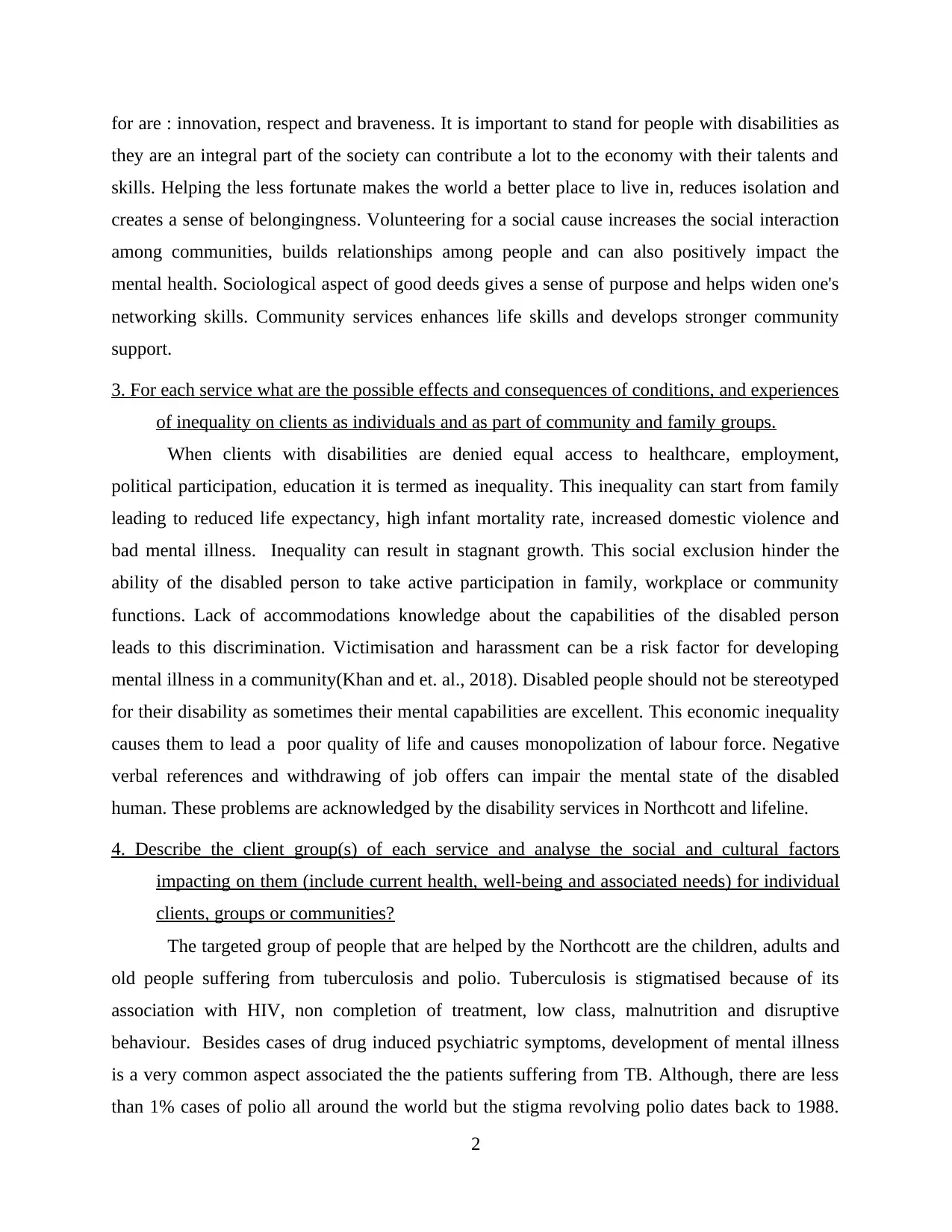
for are : innovation, respect and braveness. It is important to stand for people with disabilities as
they are an integral part of the society can contribute a lot to the economy with their talents and
skills. Helping the less fortunate makes the world a better place to live in, reduces isolation and
creates a sense of belongingness. Volunteering for a social cause increases the social interaction
among communities, builds relationships among people and can also positively impact the
mental health. Sociological aspect of good deeds gives a sense of purpose and helps widen one's
networking skills. Community services enhances life skills and develops stronger community
support.
3. For each service what are the possible effects and consequences of conditions, and experiences
of inequality on clients as individuals and as part of community and family groups.
When clients with disabilities are denied equal access to healthcare, employment,
political participation, education it is termed as inequality. This inequality can start from family
leading to reduced life expectancy, high infant mortality rate, increased domestic violence and
bad mental illness. Inequality can result in stagnant growth. This social exclusion hinder the
ability of the disabled person to take active participation in family, workplace or community
functions. Lack of accommodations knowledge about the capabilities of the disabled person
leads to this discrimination. Victimisation and harassment can be a risk factor for developing
mental illness in a community(Khan and et. al., 2018). Disabled people should not be stereotyped
for their disability as sometimes their mental capabilities are excellent. This economic inequality
causes them to lead a poor quality of life and causes monopolization of labour force. Negative
verbal references and withdrawing of job offers can impair the mental state of the disabled
human. These problems are acknowledged by the disability services in Northcott and lifeline.
4. Describe the client group(s) of each service and analyse the social and cultural factors
impacting on them (include current health, well-being and associated needs) for individual
clients, groups or communities?
The targeted group of people that are helped by the Northcott are the children, adults and
old people suffering from tuberculosis and polio. Tuberculosis is stigmatised because of its
association with HIV, non completion of treatment, low class, malnutrition and disruptive
behaviour. Besides cases of drug induced psychiatric symptoms, development of mental illness
is a very common aspect associated the the patients suffering from TB. Although, there are less
than 1% cases of polio all around the world but the stigma revolving polio dates back to 1988.
2
they are an integral part of the society can contribute a lot to the economy with their talents and
skills. Helping the less fortunate makes the world a better place to live in, reduces isolation and
creates a sense of belongingness. Volunteering for a social cause increases the social interaction
among communities, builds relationships among people and can also positively impact the
mental health. Sociological aspect of good deeds gives a sense of purpose and helps widen one's
networking skills. Community services enhances life skills and develops stronger community
support.
3. For each service what are the possible effects and consequences of conditions, and experiences
of inequality on clients as individuals and as part of community and family groups.
When clients with disabilities are denied equal access to healthcare, employment,
political participation, education it is termed as inequality. This inequality can start from family
leading to reduced life expectancy, high infant mortality rate, increased domestic violence and
bad mental illness. Inequality can result in stagnant growth. This social exclusion hinder the
ability of the disabled person to take active participation in family, workplace or community
functions. Lack of accommodations knowledge about the capabilities of the disabled person
leads to this discrimination. Victimisation and harassment can be a risk factor for developing
mental illness in a community(Khan and et. al., 2018). Disabled people should not be stereotyped
for their disability as sometimes their mental capabilities are excellent. This economic inequality
causes them to lead a poor quality of life and causes monopolization of labour force. Negative
verbal references and withdrawing of job offers can impair the mental state of the disabled
human. These problems are acknowledged by the disability services in Northcott and lifeline.
4. Describe the client group(s) of each service and analyse the social and cultural factors
impacting on them (include current health, well-being and associated needs) for individual
clients, groups or communities?
The targeted group of people that are helped by the Northcott are the children, adults and
old people suffering from tuberculosis and polio. Tuberculosis is stigmatised because of its
association with HIV, non completion of treatment, low class, malnutrition and disruptive
behaviour. Besides cases of drug induced psychiatric symptoms, development of mental illness
is a very common aspect associated the the patients suffering from TB. Although, there are less
than 1% cases of polio all around the world but the stigma revolving polio dates back to 1988.
2
Paraphrase This Document
Need a fresh take? Get an instant paraphrase of this document with our AI Paraphraser
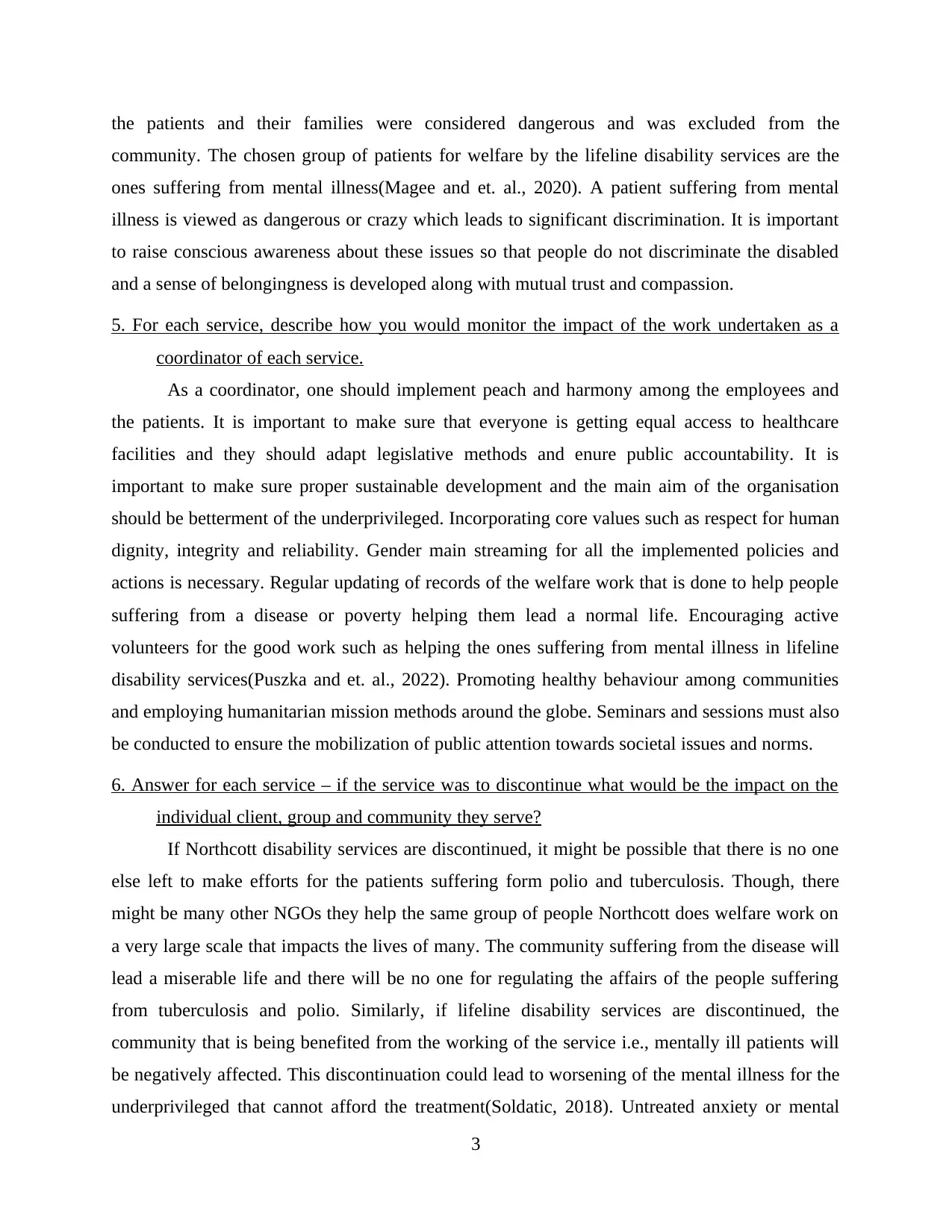
the patients and their families were considered dangerous and was excluded from the
community. The chosen group of patients for welfare by the lifeline disability services are the
ones suffering from mental illness(Magee and et. al., 2020). A patient suffering from mental
illness is viewed as dangerous or crazy which leads to significant discrimination. It is important
to raise conscious awareness about these issues so that people do not discriminate the disabled
and a sense of belongingness is developed along with mutual trust and compassion.
5. For each service, describe how you would monitor the impact of the work undertaken as a
coordinator of each service.
As a coordinator, one should implement peach and harmony among the employees and
the patients. It is important to make sure that everyone is getting equal access to healthcare
facilities and they should adapt legislative methods and enure public accountability. It is
important to make sure proper sustainable development and the main aim of the organisation
should be betterment of the underprivileged. Incorporating core values such as respect for human
dignity, integrity and reliability. Gender main streaming for all the implemented policies and
actions is necessary. Regular updating of records of the welfare work that is done to help people
suffering from a disease or poverty helping them lead a normal life. Encouraging active
volunteers for the good work such as helping the ones suffering from mental illness in lifeline
disability services(Puszka and et. al., 2022). Promoting healthy behaviour among communities
and employing humanitarian mission methods around the globe. Seminars and sessions must also
be conducted to ensure the mobilization of public attention towards societal issues and norms.
6. Answer for each service – if the service was to discontinue what would be the impact on the
individual client, group and community they serve?
If Northcott disability services are discontinued, it might be possible that there is no one
else left to make efforts for the patients suffering form polio and tuberculosis. Though, there
might be many other NGOs they help the same group of people Northcott does welfare work on
a very large scale that impacts the lives of many. The community suffering from the disease will
lead a miserable life and there will be no one for regulating the affairs of the people suffering
from tuberculosis and polio. Similarly, if lifeline disability services are discontinued, the
community that is being benefited from the working of the service i.e., mentally ill patients will
be negatively affected. This discontinuation could lead to worsening of the mental illness for the
underprivileged that cannot afford the treatment(Soldatic, 2018). Untreated anxiety or mental
3
community. The chosen group of patients for welfare by the lifeline disability services are the
ones suffering from mental illness(Magee and et. al., 2020). A patient suffering from mental
illness is viewed as dangerous or crazy which leads to significant discrimination. It is important
to raise conscious awareness about these issues so that people do not discriminate the disabled
and a sense of belongingness is developed along with mutual trust and compassion.
5. For each service, describe how you would monitor the impact of the work undertaken as a
coordinator of each service.
As a coordinator, one should implement peach and harmony among the employees and
the patients. It is important to make sure that everyone is getting equal access to healthcare
facilities and they should adapt legislative methods and enure public accountability. It is
important to make sure proper sustainable development and the main aim of the organisation
should be betterment of the underprivileged. Incorporating core values such as respect for human
dignity, integrity and reliability. Gender main streaming for all the implemented policies and
actions is necessary. Regular updating of records of the welfare work that is done to help people
suffering from a disease or poverty helping them lead a normal life. Encouraging active
volunteers for the good work such as helping the ones suffering from mental illness in lifeline
disability services(Puszka and et. al., 2022). Promoting healthy behaviour among communities
and employing humanitarian mission methods around the globe. Seminars and sessions must also
be conducted to ensure the mobilization of public attention towards societal issues and norms.
6. Answer for each service – if the service was to discontinue what would be the impact on the
individual client, group and community they serve?
If Northcott disability services are discontinued, it might be possible that there is no one
else left to make efforts for the patients suffering form polio and tuberculosis. Though, there
might be many other NGOs they help the same group of people Northcott does welfare work on
a very large scale that impacts the lives of many. The community suffering from the disease will
lead a miserable life and there will be no one for regulating the affairs of the people suffering
from tuberculosis and polio. Similarly, if lifeline disability services are discontinued, the
community that is being benefited from the working of the service i.e., mentally ill patients will
be negatively affected. This discontinuation could lead to worsening of the mental illness for the
underprivileged that cannot afford the treatment(Soldatic, 2018). Untreated anxiety or mental
3
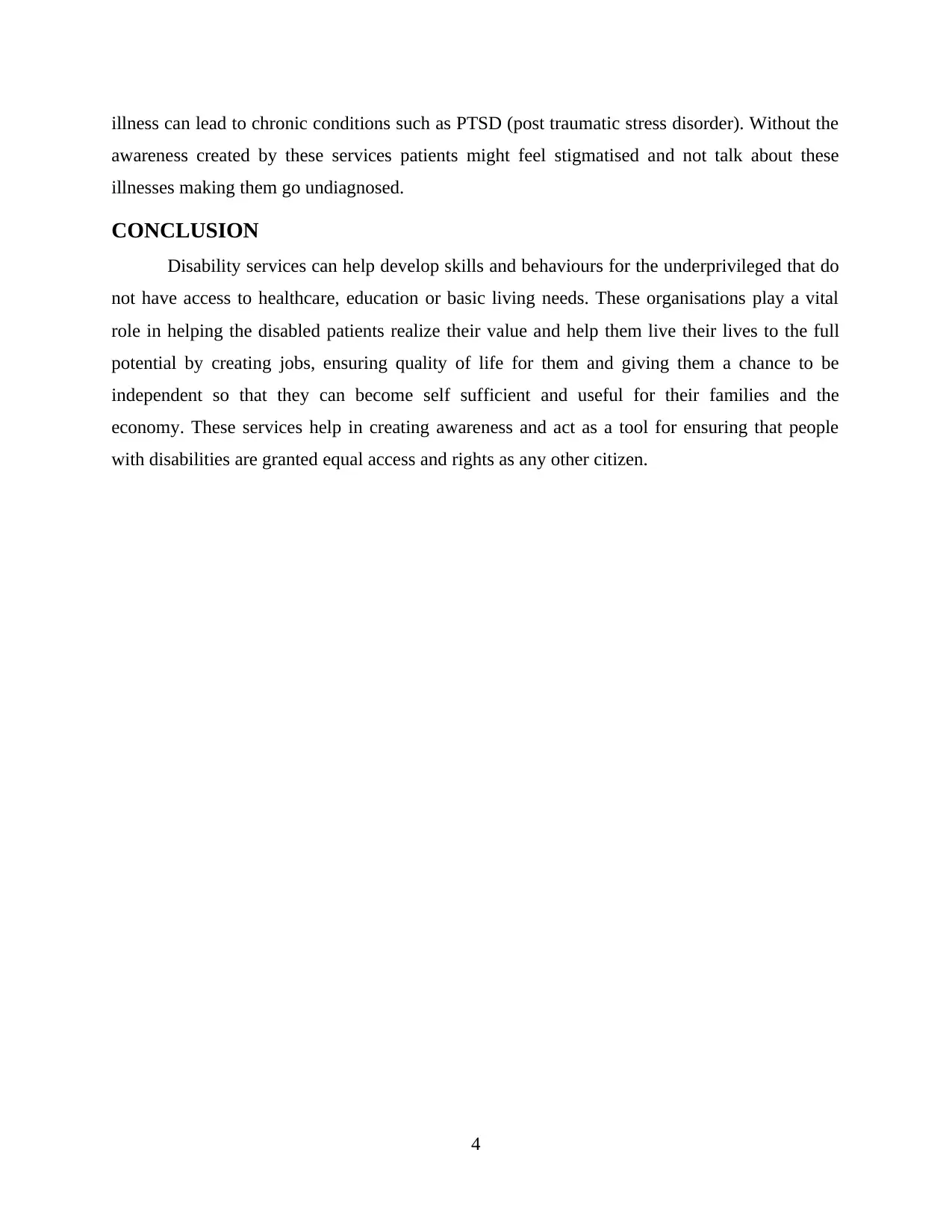
illness can lead to chronic conditions such as PTSD (post traumatic stress disorder). Without the
awareness created by these services patients might feel stigmatised and not talk about these
illnesses making them go undiagnosed.
CONCLUSION
Disability services can help develop skills and behaviours for the underprivileged that do
not have access to healthcare, education or basic living needs. These organisations play a vital
role in helping the disabled patients realize their value and help them live their lives to the full
potential by creating jobs, ensuring quality of life for them and giving them a chance to be
independent so that they can become self sufficient and useful for their families and the
economy. These services help in creating awareness and act as a tool for ensuring that people
with disabilities are granted equal access and rights as any other citizen.
4
awareness created by these services patients might feel stigmatised and not talk about these
illnesses making them go undiagnosed.
CONCLUSION
Disability services can help develop skills and behaviours for the underprivileged that do
not have access to healthcare, education or basic living needs. These organisations play a vital
role in helping the disabled patients realize their value and help them live their lives to the full
potential by creating jobs, ensuring quality of life for them and giving them a chance to be
independent so that they can become self sufficient and useful for their families and the
economy. These services help in creating awareness and act as a tool for ensuring that people
with disabilities are granted equal access and rights as any other citizen.
4
⊘ This is a preview!⊘
Do you want full access?
Subscribe today to unlock all pages.

Trusted by 1+ million students worldwide
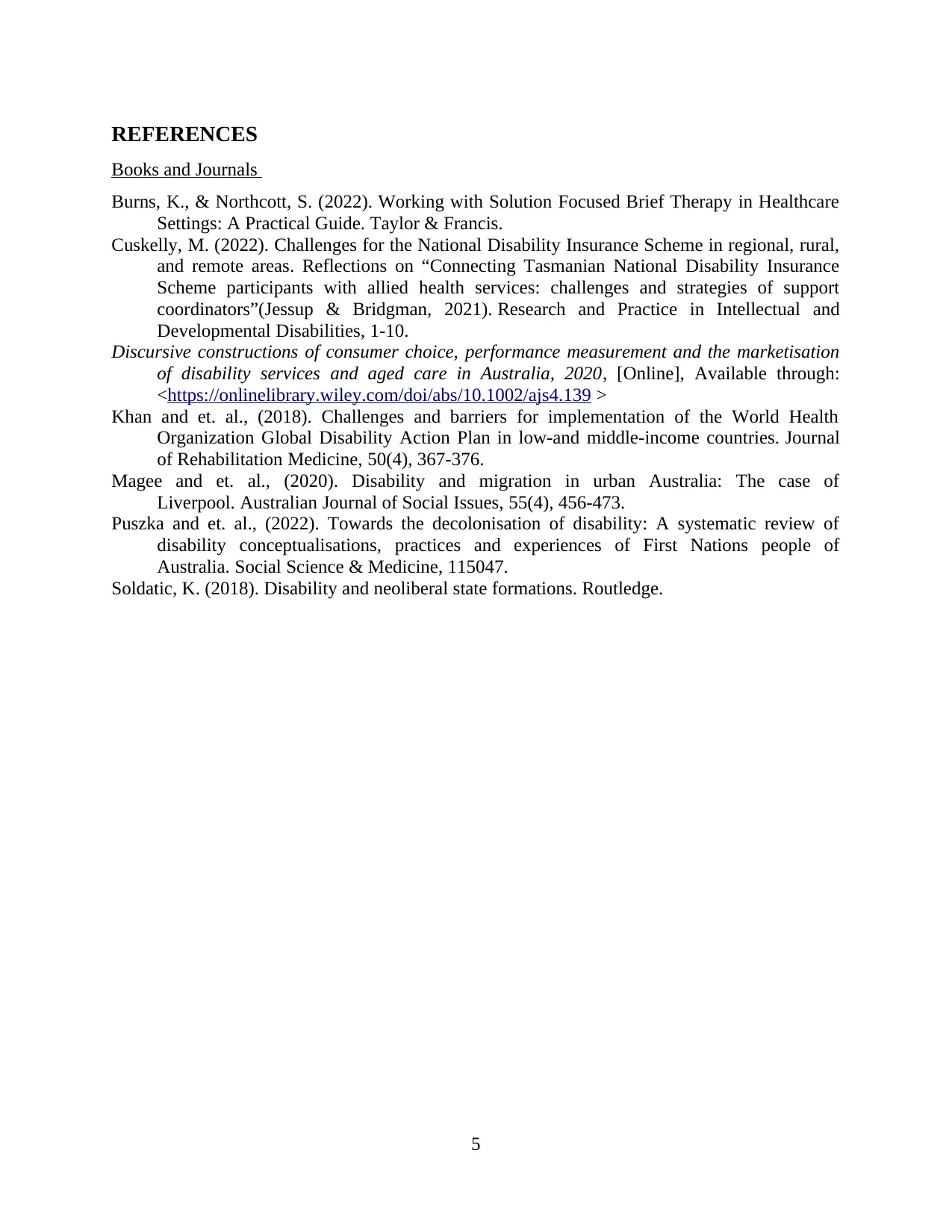
REFERENCES
Books and Journals
Burns, K., & Northcott, S. (2022). Working with Solution Focused Brief Therapy in Healthcare
Settings: A Practical Guide. Taylor & Francis.
Cuskelly, M. (2022). Challenges for the National Disability Insurance Scheme in regional, rural,
and remote areas. Reflections on “Connecting Tasmanian National Disability Insurance
Scheme participants with allied health services: challenges and strategies of support
coordinators”(Jessup & Bridgman, 2021). Research and Practice in Intellectual and
Developmental Disabilities, 1-10.
Discursive constructions of consumer choice, performance measurement and the marketisation
of disability services and aged care in Australia, 2020, [Online], Available through:
<https://onlinelibrary.wiley.com/doi/abs/10.1002/ajs4.139 >
Khan and et. al., (2018). Challenges and barriers for implementation of the World Health
Organization Global Disability Action Plan in low-and middle-income countries. Journal
of Rehabilitation Medicine, 50(4), 367-376.
Magee and et. al., (2020). Disability and migration in urban Australia: The case of
Liverpool. Australian Journal of Social Issues, 55(4), 456-473.
Puszka and et. al., (2022). Towards the decolonisation of disability: A systematic review of
disability conceptualisations, practices and experiences of First Nations people of
Australia. Social Science & Medicine, 115047.
Soldatic, K. (2018). Disability and neoliberal state formations. Routledge.
5
Books and Journals
Burns, K., & Northcott, S. (2022). Working with Solution Focused Brief Therapy in Healthcare
Settings: A Practical Guide. Taylor & Francis.
Cuskelly, M. (2022). Challenges for the National Disability Insurance Scheme in regional, rural,
and remote areas. Reflections on “Connecting Tasmanian National Disability Insurance
Scheme participants with allied health services: challenges and strategies of support
coordinators”(Jessup & Bridgman, 2021). Research and Practice in Intellectual and
Developmental Disabilities, 1-10.
Discursive constructions of consumer choice, performance measurement and the marketisation
of disability services and aged care in Australia, 2020, [Online], Available through:
<https://onlinelibrary.wiley.com/doi/abs/10.1002/ajs4.139 >
Khan and et. al., (2018). Challenges and barriers for implementation of the World Health
Organization Global Disability Action Plan in low-and middle-income countries. Journal
of Rehabilitation Medicine, 50(4), 367-376.
Magee and et. al., (2020). Disability and migration in urban Australia: The case of
Liverpool. Australian Journal of Social Issues, 55(4), 456-473.
Puszka and et. al., (2022). Towards the decolonisation of disability: A systematic review of
disability conceptualisations, practices and experiences of First Nations people of
Australia. Social Science & Medicine, 115047.
Soldatic, K. (2018). Disability and neoliberal state formations. Routledge.
5
1 out of 7
Related Documents
Your All-in-One AI-Powered Toolkit for Academic Success.
+13062052269
info@desklib.com
Available 24*7 on WhatsApp / Email
![[object Object]](/_next/static/media/star-bottom.7253800d.svg)
Unlock your academic potential
Copyright © 2020–2025 A2Z Services. All Rights Reserved. Developed and managed by ZUCOL.





